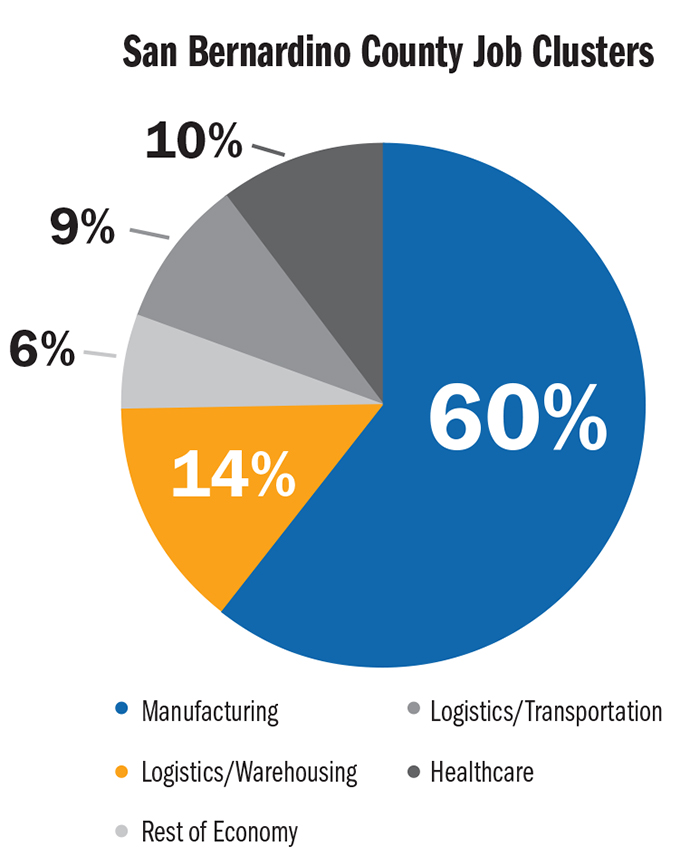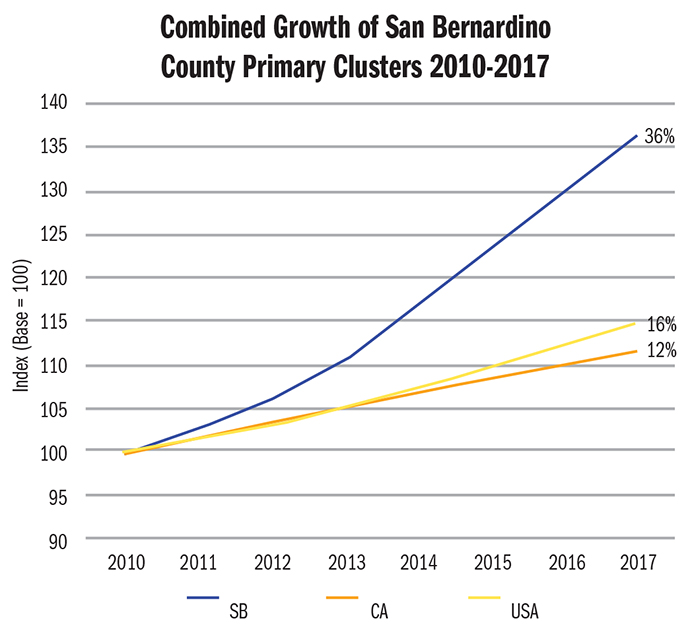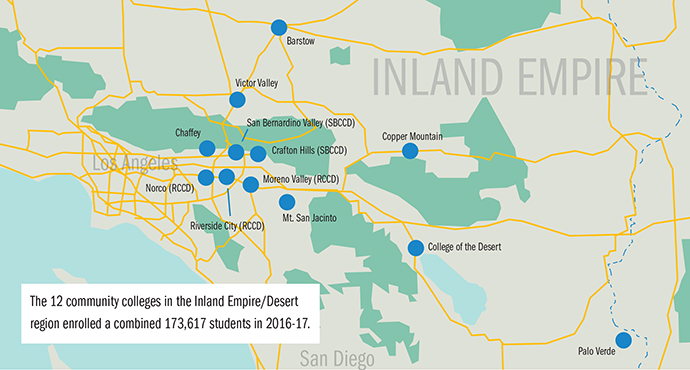The Industrial Technical Learning Center (InTech) at Chaffey College in Fontana, California, is the kind of place where individual dreams and company goals can both be realized. Launched in 2014 with a $14.9-million TAACCCT [Trade Adjustment Assistance Community College and Career Training] grant, and with backing from companies and the region’s 12 community colleges, the center is blazing new trails.
"The InTech partnership between California Steel and Chaffey College is an exemplary Apprenticeship model that aligns academic learning with hands-on, practical on-the-job learning," says Gino DiCaro, vice president of communications for the California Manufacturers & Technology Association. "Employers and community colleges up and down the state can learn from this highly successful apprenticeship program."
They can, and they should.
"The U.S manufacturing sector is advancing rapidly, and the pathways to developing and acquiring talent must change to keep pace," DiCaro says. "Secondary education must reflect current employment needs by offering a wider variety of training options for career choices, including apprenticeships that take the place of typical school programs for technical-style work."

Across-the-board buy-in is taking place in San Bernardino County in Southern California — with full support from the California Apprenticeship Initiative. The training option derives from innovation and necessity, considering the expected jobs growth. If the Inland Empire were a state, it would be the 40th largest by area and the 26th largest by population. Moreover, it’s a region projected to add 157,860 jobs between 2017 to 2022 — a 10-percent jump.
A number of colleges and high schools in San Bernardino County are working through a system-wide agreement that will offer apprenticeship pathways in every local area and industry sector.
"An apprenticeship is a highly effective way for a business to get new talent into their company, teach applicable skills and techniques and further develop their existing employees," says Stephanie Murillo, administrative supervisor, San Bernardino County Workforce Development Board, which runs three Americas Jobs Centers. "This collaborative effort combines resources and engages our regional business community to develop a workforce tailored to the needs of the county’s economy."

The Inland Empire/Desert Regional Consortium Strong Workforce Program Regional Plan draft, expected to be finalized in January 2019, identifies six target sectors offering the most promise for opportunity in coming years: advanced manufacturing; advanced transportation and logistics; energy, construction and utilities; health; ICT and digital media; and business and entrepreneurship.
"While the concept of an apprentice has been around for some time, it is a model used historically by the building trades and military," Murillo says. "Now it’s back in vogue as more companies, educators, policy makers and non-profit groups come together to reduce the skills deficit."
Expertise Begins With Listening
Rod Hoover’s known the power of apprentices for some time. The human resources manager for California Steel Industries, Inc. (CSI) has worked at the location in Fontana since it was Kaiser Steel back in the early 1980s, and will retire next year. "We’re one of the largest non-union steel manufacturing facilities in the country," he says, "and part of my function is to keep it staffed with qualified people."
His work championing apprenticeship and certifications will be part of his legacy to CSI and to the region.
"We have developed over 120 craft people since 1999, and we have 30 in training right now," he says, noting that CSI’s capability to turn out a journey-level industrial maintenance specialist, electrician or mechanic in two years instead of the usual apprentice track of four to five years can save a company up to $150,000. One big reason for that efficiency? The program — now certified by the state — is skills-based, not time-based. CSI is front and center in championing the program, but accounts for just a small portion of the 1,700 apprentices in the county who have graduated.

"Companies find apprentices learn quickly," says Norco College Apprenticeship Director Charles Henkels. "In turn we can learn and respond more quickly to what industry needs because when someone’s an apprentice, they’re also a student in the community college providing us more feedback."
"We’re dialed in to the voice of the business," says Sandra Sisco, director, economic development, for the TAACCCT Grant & InTech Learning Center at Chaffey College, noting the importance of two registered apprentice occupations in particular: industrial maintenance electrical technician and industrial maintenance mechanic. It’s not just manufacturers who need them.
"Hospitals and logistics operations need those two occupations because they both have industrial equipment," she says. "That’s where the shortage in the workforce is, not just in California, but around the world. So we feel very blessed to be able to create this pipeline of skilled workers."
The response from employers has been enthusiastic. Nestle Waters is incorporating the industrial mechanic apprenticeship into its long-term sustainability plan for its San Bernardino County facility. General Atomics Aeronautical System’s (GA-ASI’s) Field Avionics Department in Adelanto has been working with the State of California Department of Apprenticeship Standards (DAS), Victor Valley College (VVC), and the Victor Valley College Foundation to create the GA-ASI Electronics Technician Apprenticeship program.

The primary goal of the program is to produce 60 Field Avionics Technicians a year to accommodate General Atomics’ business needs. The program will consist of 480 hours of classroom training and 3,040 hours of On-the-Job (OJT) training. Classroom training will be delivered via contract education through VVC in the form of five for-credit classes. GA-ASI is currently in the process of securing a facility at the Southern California Logistics Airport (SCLA) in Victorville for these classes through a partnership with the San Bernardino County Workforce Development Board (WDB) and Stirling Development. OJT training will take place between the facility at SCLA and GA-ASI’s Flight Operations Facilities in the high desert. A Pre-Apprenticeship program is also being assembled for individuals who are not initially selected but have demonstrated the potential for success in the program.
Hoover says a recent meeting featured around 25 more manufacturers wanting to get on board. They’re part of a manufacturing cluster in the region that numbered around 4,500 firms a few years ago. They employed 90,000 then, but that number has now grown to 120,000.
Grow Your Own
CSI employs around 1,000 at its operation, with about 15 active apprentices at any given time.
"If I were a company trying to get a foothold in California, even with low unemployment, there is a great talent pool out here," Hoover says. Typically, around 80 apply for the slots at CSI, coming out of training programs or by word of mouth.
The talent base is good for those growing warehouse operators too, even as automation grows. If a job is displaced by technology, "then the money is in the maintenance of that equipment," Hoover says. "Those are good-paying jobs, in demand well into the future." Norco College, the host college for the National Center for Supply Chain Automation, has created a national template for a registered apprenticeship program.
How good is the ultimate pay? At CSI, with shift differentials, overtime and profit sharing, electricians can make between $90,000 and $100,000 "easily," and mechanics anywhere from $80,000 up to $95,000, before benefits, says Hoover. That level of pay still goes a long way in a region with a cost of living around 60 percent that of Los Angeles.
Creating Career Pathways
Training through apprenticeships is just one aspect of the county’s commitment to support development of a strong workforce.
Career pathway programs, designed to help students and young adults throughout San Bernardino County prepare for opportunities in growth industries, will receive a boost under an innovative new effort.
The San Bernardino County Career Pathways Compact is a framework for a formal pathways network that helps youth attain the knowledge, skills and experience required for productive, sustainable careers. Among the goals of the Compact is assuring that graduating high school students are able to enter their career field, gain acceptance into college or a vocational program, or become a registered apprentice. Participating students are co-enrolled in community college and earn college credits when they graduate.

This compact, which started with the San Bernardino Unified School District, San Bernardino Community College District and the WDB, will be scaled up to all 33 school districts across the county and its community colleges, serving upwards of 30,000 high school students each year.
"Many of these students are being exposed to career opportunities they never imagined possible, and in the process are receiving hands-on training and certification they can use to obtain employment. It’s a win for them and for businesses," says Murillo.
Career pathways are a pillar of WDB’s GenerationGo!, a work-based learning initiative. Recently, 14 students from San Bernardino’s Cajon High School completed 120 hours of clinical practice in a GenerationGo! pilot program with Arrowhead Regional Medical Center, learning about a variety of career opportunities while being further propelled along a valuable career path.
With the buy-in of companies, institutions, students, parents and area leaders, these programs, along with the focus on re-engaging apprenticeship training, are making the county’s talent pool deeper.
For companies looking to do business in San Bernardino County, these programs underscore the county’s commitment to collaborate with every business sector to provide for skilled talent now and into the future.
This Investment Profile was prepared under the auspices of San Bernardino County government. Employers interested in San Bernardino County Workforce Development Board programs may call (800) 451-JOBS or visit www.sbcounty.gov/workforce. For more information, contact the county Economic Development Agency at 909-387-4700. On the web, go to www.sbcountyadvantage.com.
